While looking for two residential buildings merged into a unique architectural ensemble in a completely wrong place, which I wrote about in the previous sequel of my travel stories on the trip to Čačak and Ovčar Banja, I came to yet another monument of culture and this was the house of Major Gavrilović in Cara Lazara street.
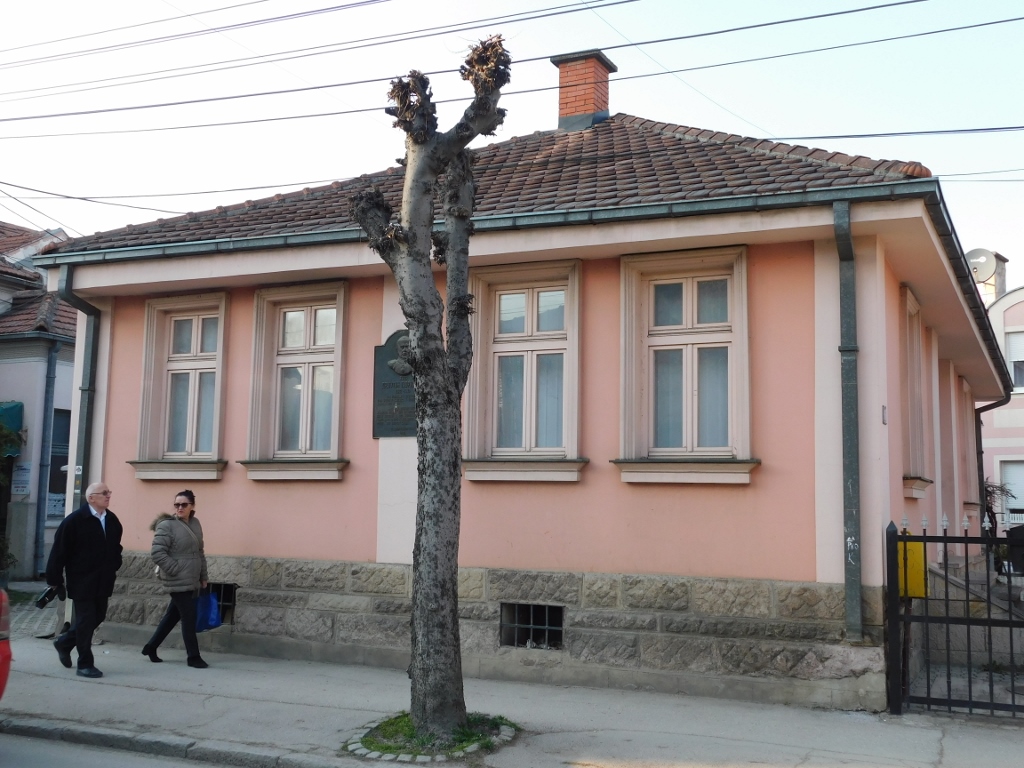 House of Major Gavrilović
House of Major Gavrilović
Major Dragutin Gavrilović was born in 1882 in the house which his father built between 1863 and 1869. This officer distinguished himself in the 1912-1918 wars (two Balkan wars and WWI) and for this he received numerous Serbian and International medals. Although he was promoted into the rank of colonel in 1920, he is most often mentioned with the rank of major, primarily because of the famous speech he held on 7 October 1915 when defending Belgrade from the Austro-Hungarian and German attack. I think that there is not a single pupil in Serbia who has not heard of this speech at the history classes.
“Soldiers! Exactly at three o’clock, the enemy is to be crushed by your fierce charge, destroyed by your grenades and bayonets. The honour of Belgrade, our capital, must not be stained.
Soldiers! Heroes! The supreme command has erased our regiment from its records. Our regiment has been sacrificed for the honour of Belgrade and the Fatherland... You no longer need to worry about your lives, for they no longer exist... So, forward to the glory! For the King and the Fatherland! Long live the King! Long live Belgrade!”
There are a couple of interesting points linked to this, however. The first one is that not everybody from the regiment got killed in this battle as one may think, including Major Gavrilović himself who was admittedly badly wounded. Major Gavrilović died in Belgrade in 1945.
The second thing is that there is data that says that Major Gavrilović never actually gave this speech, but rather that it was invented by Đorđe Roš who was also badly wounded in this charge, since he was under the command of Major Gavrilović. Đorđe Roš is a particularly interesting figure from our history, but I will leave the story about him for another time.
As for the downtown area of Čačak, here I actually finished with my sightseeing, so I went back to the parking lot and got my car. The final destination for the day was Ovčar Banja, but I had a couple of more stops on my way there.
The first one was by the yard of the Church of the Assumption of the Theotokos in settlement Beljina near Čačak. Namely, there is an archaeological site here from the period from the 2nd to the 4th century CE, although the oldest finds belong to the prehistoric era. The materials I had with me mentioned different details linked to a discovered necropolis and a settlement, but when one gets to the church there is nothing (apart from the church) to be seen there.
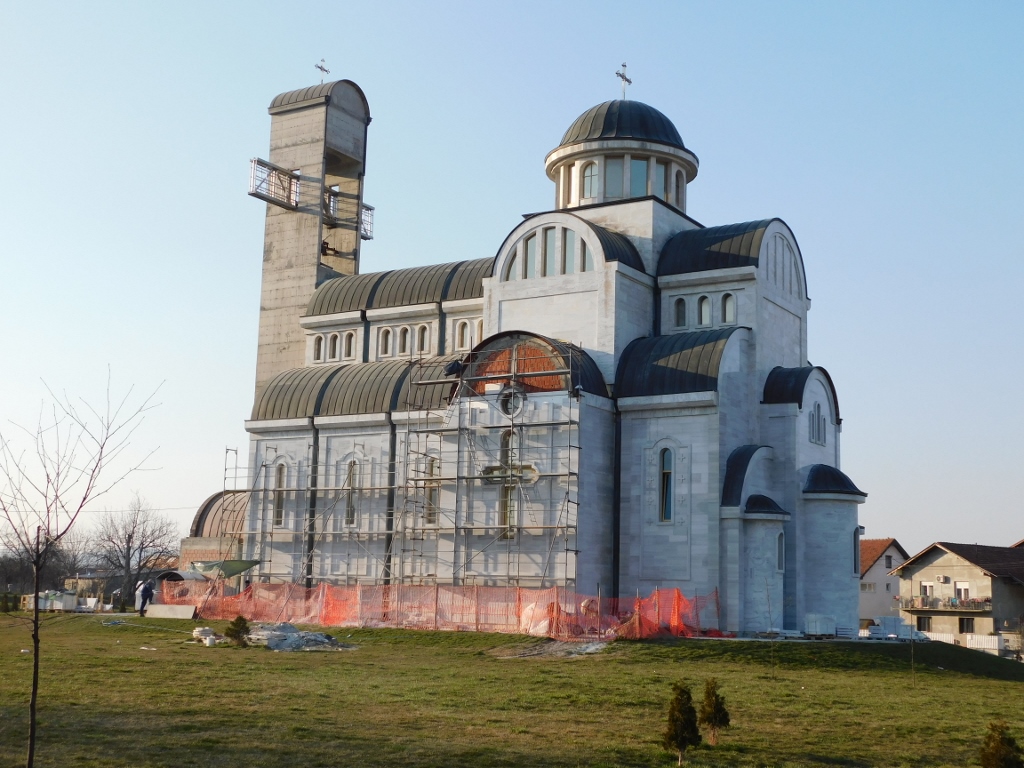 Church of the Assumption of the Theotokos and its yard
Church of the Assumption of the Theotokos and its yard
The church itself is new and its construction started in 1991, it has been used since 2010 and the construction of the bell tower started in 2016.
The entrance into the church faces the Lupnjača stream and on the other side there is another archaeological site. The site includes the Roman baths in Beljina. The remains of the Roman baths were discovered during the 1980s and it was established that they were private, i.e., that they belonged to an agricultural farm. Still, after the surveying, the site was conserved and then covered again with soil in order to protect it. Consequently, nothing can be seen there today.
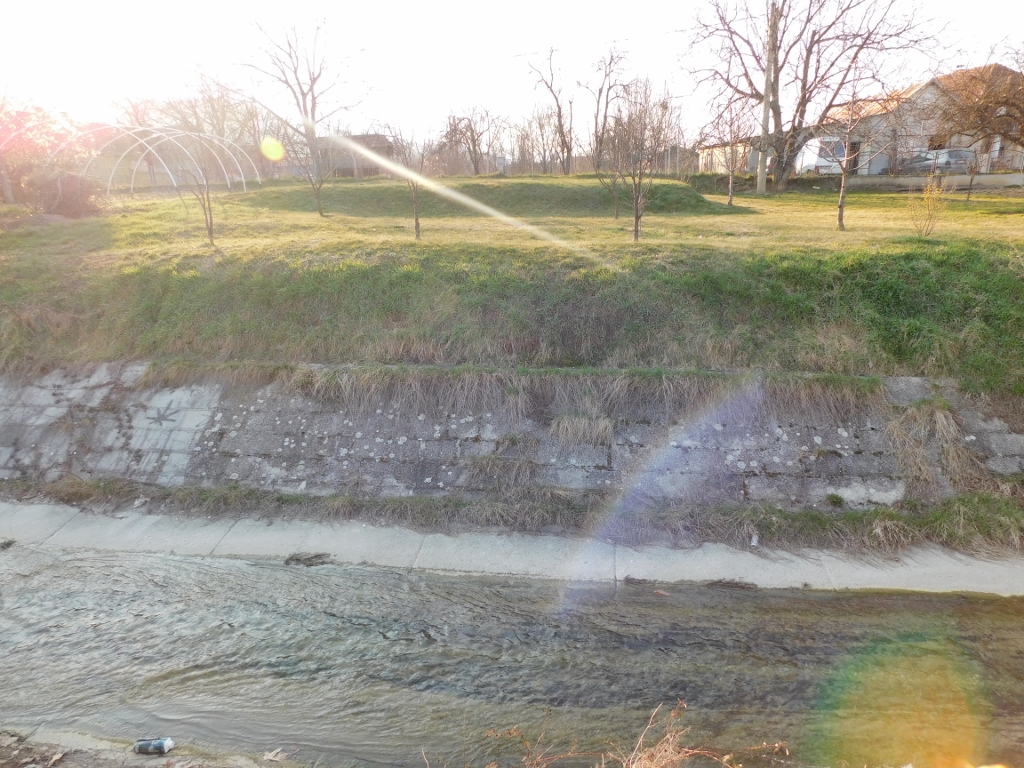 View across the Lupnjača stream towards the archaeological site in Beljina near Čačak
View across the Lupnjača stream towards the archaeological site in Beljina near Čačak
Now I was definitely leaving the urban area of Čačak, heading for Ovčar Banja, a spa, that is situated some 20 km west of Čačak. Here is the map:
My plan was to make a few more breaks before reaching the spa, but it did not work out this way. The first reason was that during that horrible traffic jam when entering Čačak my car started to act weird. By now, it drove well and sounded as usual, but I was nervous because of this and therefore wanted to reach Ovčar Banja soon. The other reason for adjusting my sightseeing plan was that the day was already getting close to its end and therefore I did not feel like being caught in the dark, since I worried about the car.
All in all, I just passed by an exit from the main road leading to village Pakovraće that would take me to the next monument of culture within my original plan and that was the Metochion of the Monastery of the Meeting of the Lord in the Temple (Sretenje). By the way, the word metochion comes from Greek and it is used to denote monastic estates or property that can provide income for the monastery. Both the Monastery of the Meeting of the Lord in the Temple and its metochion are located on mount Ovčar. The metochion, founded around the middle of the 19th century includes, among other things, a dormitory built for the temporary stay of nuns during the agricultural works in the vineyard and the farm. Driving on from this exit, I thought that now I knew where this was, so I could come and visit some other time. I just kept on driving.
Only a kilometre after the exit to the Metochion of the Monastery of the Meeting of the Lord in the Temple I reached a parking beside the road from where it is possible to enter the Monastery of the Entrance of the Theotokos into the Temple (Vavedenje).
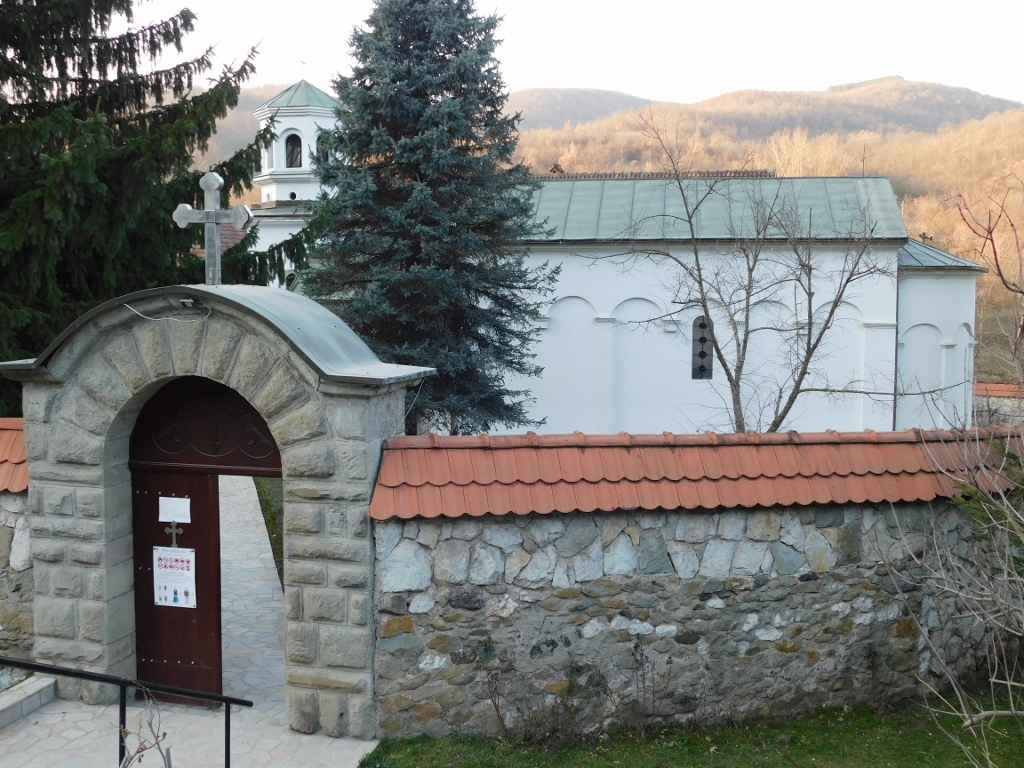 Monastery of the Entrance of the Theotokos into the Temple
Monastery of the Entrance of the Theotokos into the Temple
According to the legend, this monastery was built by Saint Sava (1169 or 1174-1236), the first Archbishop of the autocephalous Serbian Orthodox Church, and his father Stefan Nemanja (around 1113-1199), who was the Grand Prince of Raška, founder of the ruling Nemanides dynasty and one of the founders of the Serbian Orthodox Church. He became a monk towards the end of his life and was also canonised later on (Saint Simeon). However, the first mention of the monastery in the Ottoman data was only in 1528.
During its history, the monastery was ruined and restored several times. The church that may be seen here today was renewed in 1930, while the monastery became female monastery in 1975.
At the main entrance door leading into the church yard, there are clear instructions regarding the behaviour of visitors. I had already known some of these, so I was prepared. Namely, this monastery, as well as other monasteries in the Ovčar-Kablar Gorge, among which there are certain practical differences, is very traditional and among other things, women are allowed in only in long skirts (no pants or shorts). It is also required that the arms are covered and it is not permitted to enter in sleeveless shirts.
As for my arms, I was fine since it was cold anyway, so I had my jacket on. And as for the skirt, I have for these occasions a long skirt that is kept while being tied into a knot and is “naturally” crumpled, so it is easy to carry in a small backpack. Before entering a monastery, I simply put it on over my pants and then there are no problems.
On the other hand, it was not permitted to take photos at the monastery, so the only photo I have from here is the one that may be seen above.
But, let me say something about the monasteries in the Ovčar-Kablar Gorge. Namely, after the defeats of the Serbs in the Battles of Maritsa in 1371 and of Kosovo in 1389, there was a displacement of the political and cultural centre of Serbia to the north, to the areas around the Velika Morava and the Zapadna Morava rivers. It was precisely towards the end of the 14th century that the monasteries in the Ovčar-Kablar Gorge were mentioned for the first time. There is almost no data from the 15th century, but their activities revived during the 16th and the 17th centuries. The last period in which art in the form of the medieval Serbian tradition flourished at these monasteries was the first half of the 17th century.
Because of the number of the monasteries in this very small area (10 monasteries and 2 churches), this whole part is often referred to as the Serbian/Minor Mount Athos (in some Orthodox traditions Mount Athos, Greece, is called “Holy mountain” which is the literal translation of “Sveta gora” used here). My plan was to visit them all on this occasion.
After my visit to the Monastery of the Entrance of the Theotokos into the Temple, I stopped briefly in one other parking lot on the right-hand side of the road used for the visits to a few restaurants that exist here on the shore of a smallish reservoir created along the riverbed of the Zapadna Morava for the needs of the “Međuvršje” hydro-electric plant, which you pass by when going from the Monastery of the Entrance of the Theotokos into the Temple towards Ovčar Banja. The view was nice, especially as it was almost the end of the day, although you can see that it was still early spring and the deciduous forests covering the surrounding hills had still not developed their foliage.
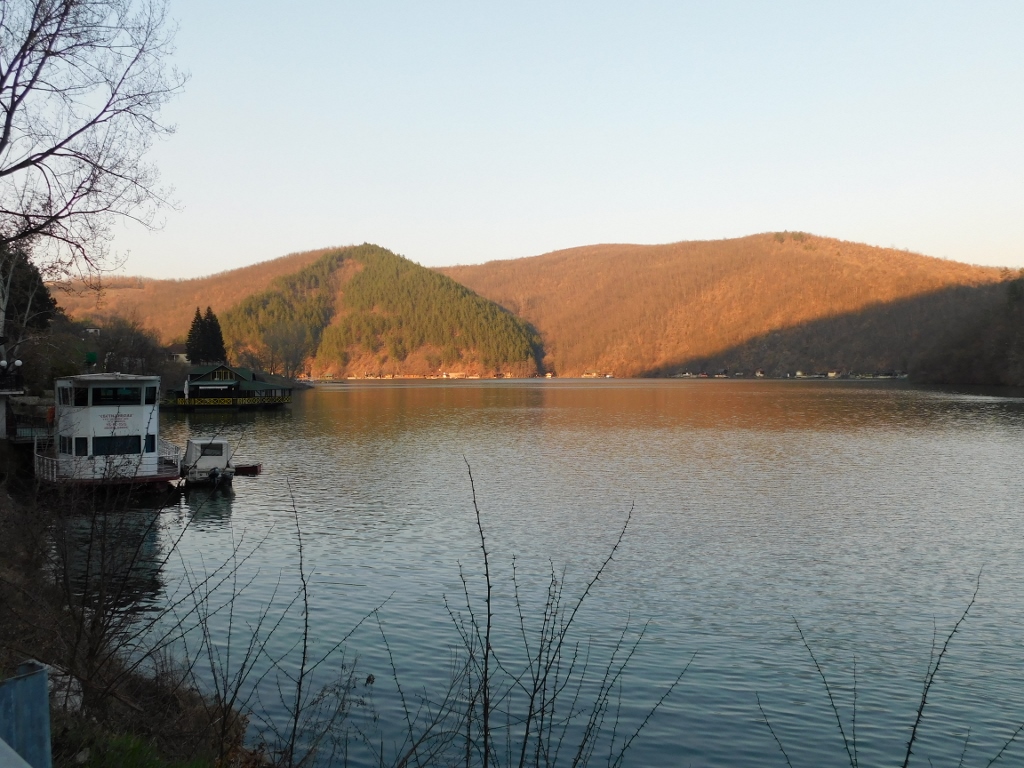 The Zapadna Morava that widens her on account of the reservoir
The Zapadna Morava that widens her on account of the reservoir
I also planned to make a stop at the Monastery of the Ascension of our Lord on my way to Ovčar Banja, but although it was announced by a large info board, I could not see any sign showing where to turn. So, I left to deal with this after I had settled at Ovčar Banja, which was soon enough. This time, I decided to take a room at a small, but modern hotel at the spa (banja is the Serbian word for a spa).
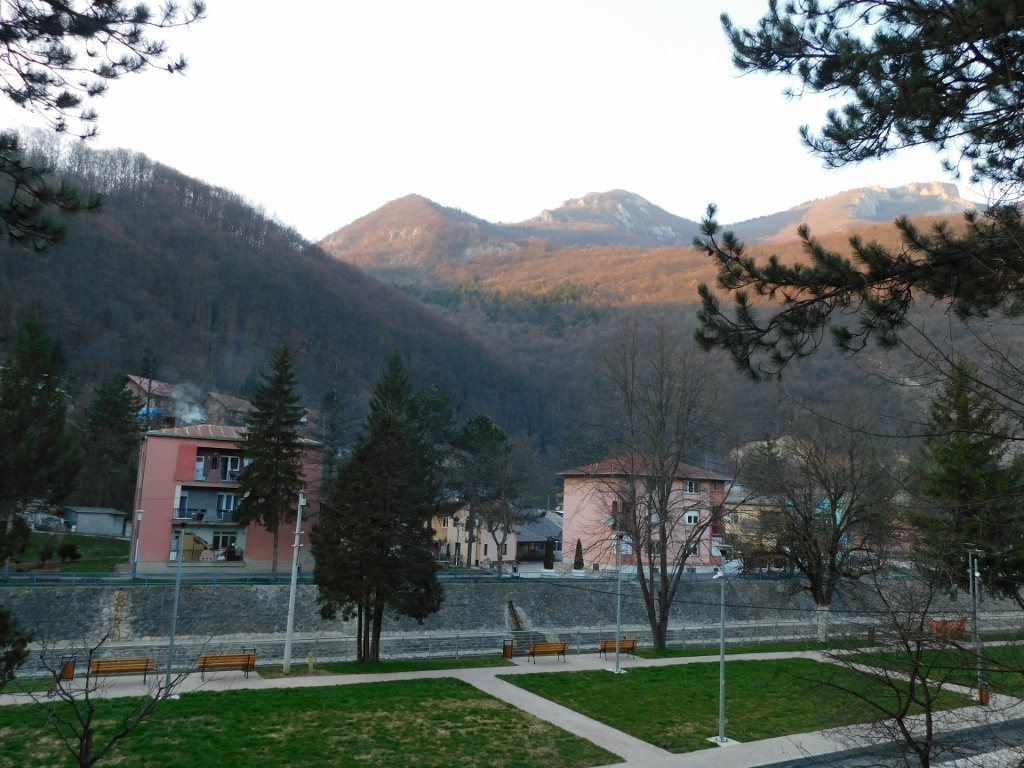 Room with a view at mount Kablar
Room with a view at mount Kablar
The next morning was fresh, but sparkling. Although I have been numerous times in Ovčar Banja and hiked across mountains Kablar and Ovčar, which I considered easy hiking at the time, I felt some trepidation now. I hadn’t hiked properly for a long time, walking over flat areas cannot be good preparation for climbing up, my years have, lo and behold!, piled up and by this time I was constantly exhausted with too much work and obligations at home. So, what was I to do under such circumstances? Move on right away, directly and as soon as possible.
Well, not really. First I had breakfast at the hotel and then I decided that I would not go to visit the monasteries of Annunciation and St. Elijah that are situated in the spa itself. I hoped to be able to go and visit them later when I return from my hike across Kablar. For this was what I decided. On this first day in the spa, I would go to mount Kablar.
I started from the hotel and there I first walked along a canal with the water of the Zapadna Morava coming from the “Ovčar Banja” hydro-electric plant that passes through a tunnel dug in the hill on which the monasteries of Annunciation and St. Elijah are located.
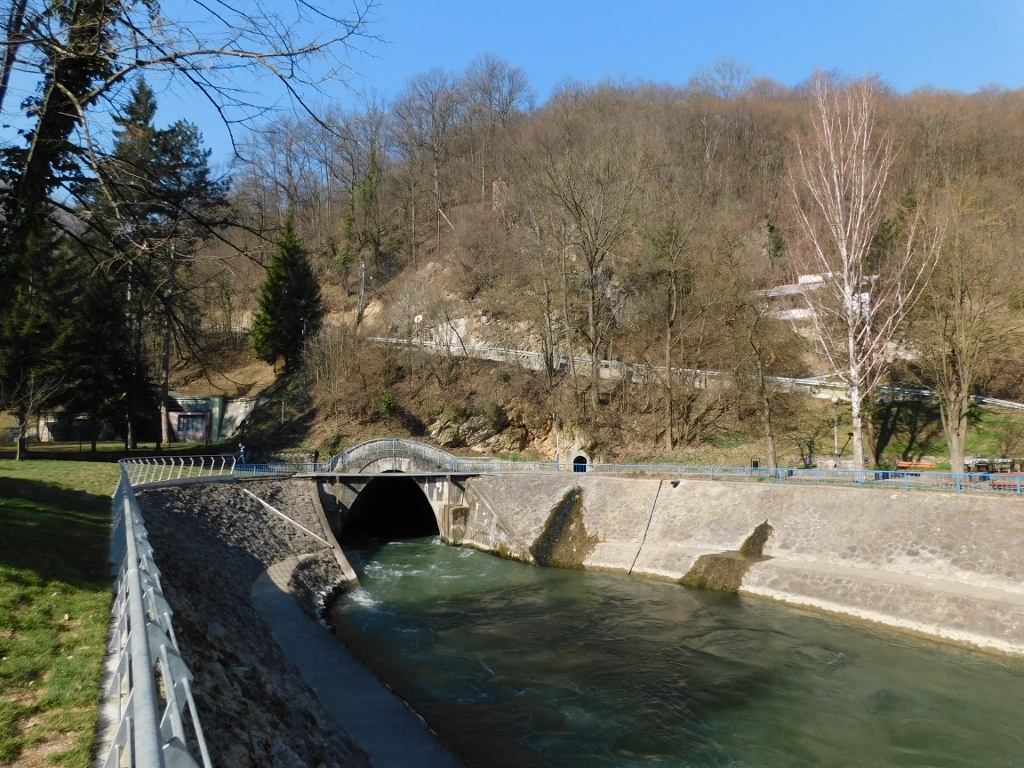 Ovčar Banja, a detail
Ovčar Banja, a detail
On the opposite side, in addition to the Zapadna Morava canal, I could also see mount Kablar.
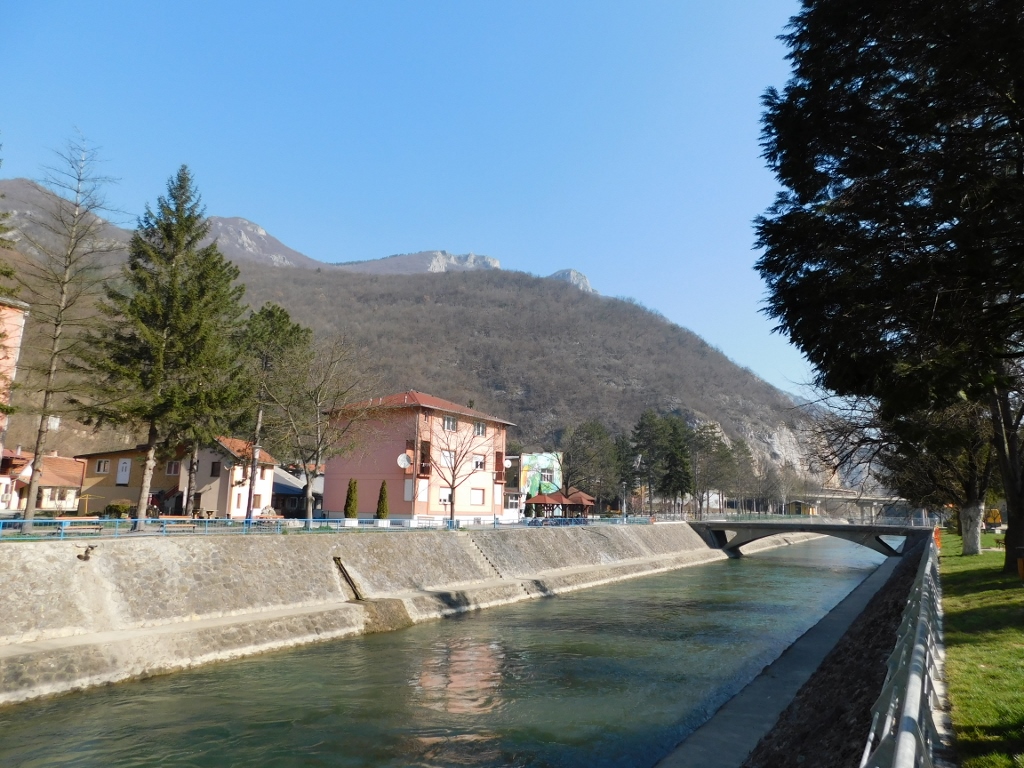 Ovčar Banja, a detail
Ovčar Banja, a detail
Mount Kablar is 889 m high, while Ovčar Banja is situated at 278 m a.s.l. My plan was to go to Savina Voda first that is also called the Hermitage of St. Sava or the Church of Savinje.
From the promenade along the canal and later from along the riverbed of the Zapadna Morava, one can see nicely both the cliffs of mount Kablar and the Hermitage of St. Sava. In the next photo, a part of the small church dedicated to St. Sava may be seen in the lower right-hand corner of the photo. You can also see some birds circling above the mountain on which they have their nests.
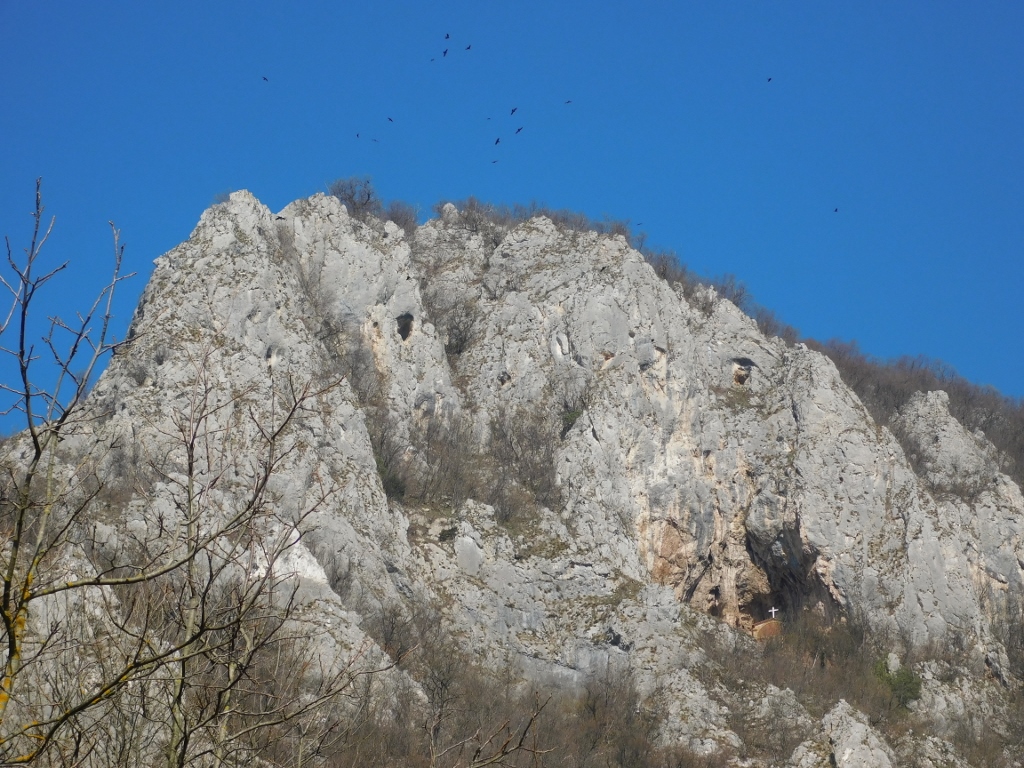 Kablar and the Hermitage of St. Sava
Kablar and the Hermitage of St. Sava
Many years ago, when I was here for the first time, I went with my fellow hikers precisely to Savina Voda. Every time after that, when hiking across Kablar, we followed another trail. I remember climbing up to Savina Voda as very strenuous. So, why did I choose to go this way now? Because I did not know exactly where the other trail started and I knew about the one to Savina Voda, since it leaves from the former mountain lodge of a club I used to be a member of a long time ago. Meanwhile things have changed – primarily in the number of signs and even more often in the form of frequent trail blazing, so I did see along the way a clearly marked trail that was easier, but by this time I had already made up my mind about going to Savina Voda first.
In order to get to Savina Voda, I followed trail no. 2 that had an exclamation mark next to the number, meaning that even today it is considered more difficult, so it was not only a question of my memory. I was really keen on getting to Savina Voda, i.e., the Hermitage of St. Sava, so I opted for this trail irrespective of the exclamation mark. After the experience I had here this time, I must say right away that this is absolutely not a trail for people who are not fit and who have no hiking experience. My fitness was feeble, but I used my experience to the fullest. It was also good that I had trekking poles. What I know now, however, is that I will NEVER walk this trail again.
It all started quite innocently.
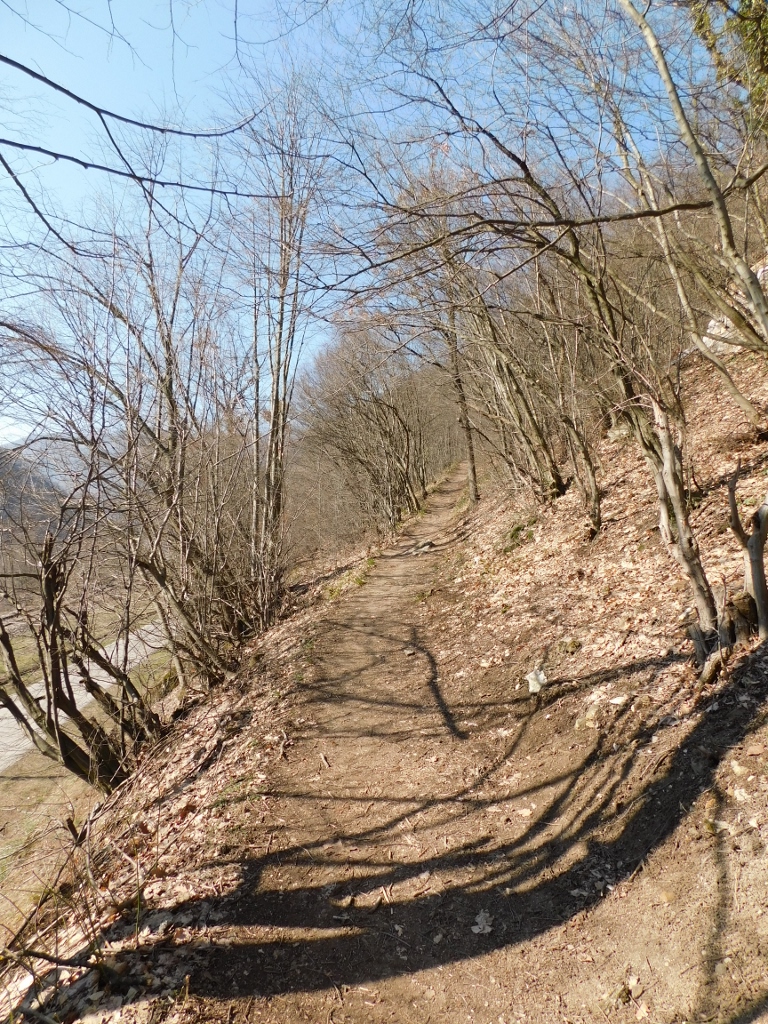 Beginning of trail no. 2 leading to the Hermitage of St. Sava
Beginning of trail no. 2 leading to the Hermitage of St. Sava
In this area, mountains Ovčar and Kablar are very close one to the other and they are only separated by the narrow riverbed of the Zapadna Morava, which all together constitutes the Ovčar-Kablar Gorge. This gorge is registered as the landscape of exceptional features and as such it is under the protection of the state. The slopes of Ovčar are covered in forests, but on Kablar’s side of the gorge, although there are forests, there is also a large number of sheer cliffs and thus, in addition to the trails used by hikers, alpine climbers also have their own practicing routes here.
After the easy beginning, the trail started to be steeper and steeper and there were more rocky parts of the trail, so I had to walk more carefully and it was becoming more difficult. Luckily, there were some gorgeous sights that I kept coming across and they were an ideal excuse before myself to make frequent breaks.
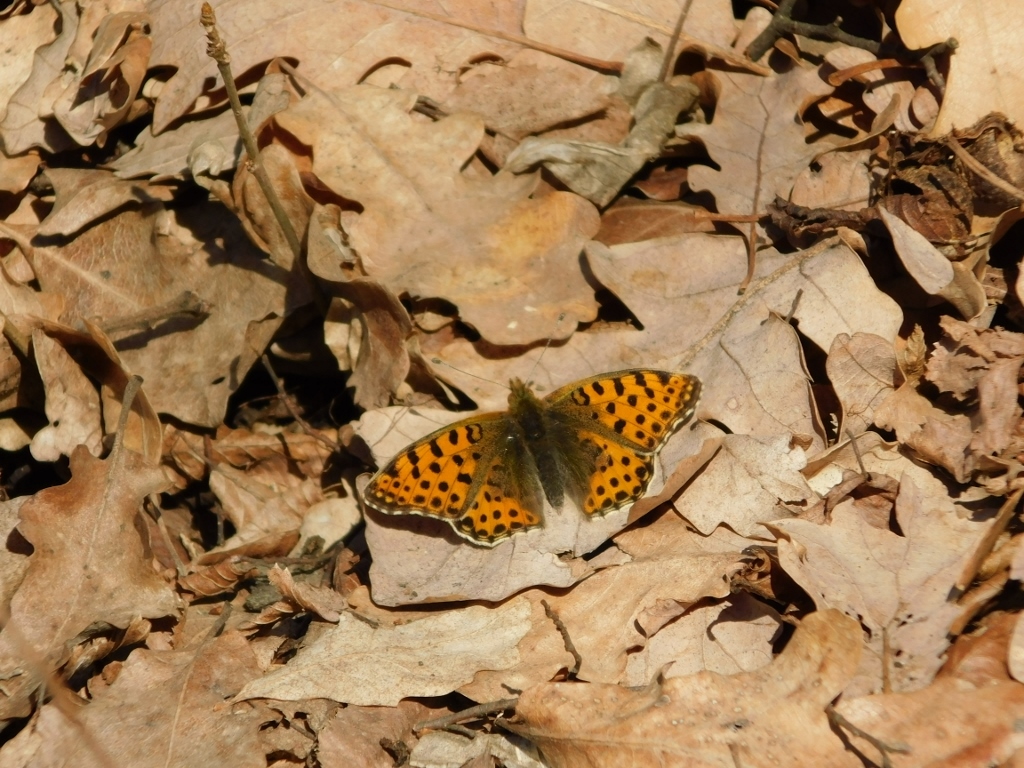 Queen of Spain fritillary (Issoria lathonia)
Queen of Spain fritillary (Issoria lathonia)
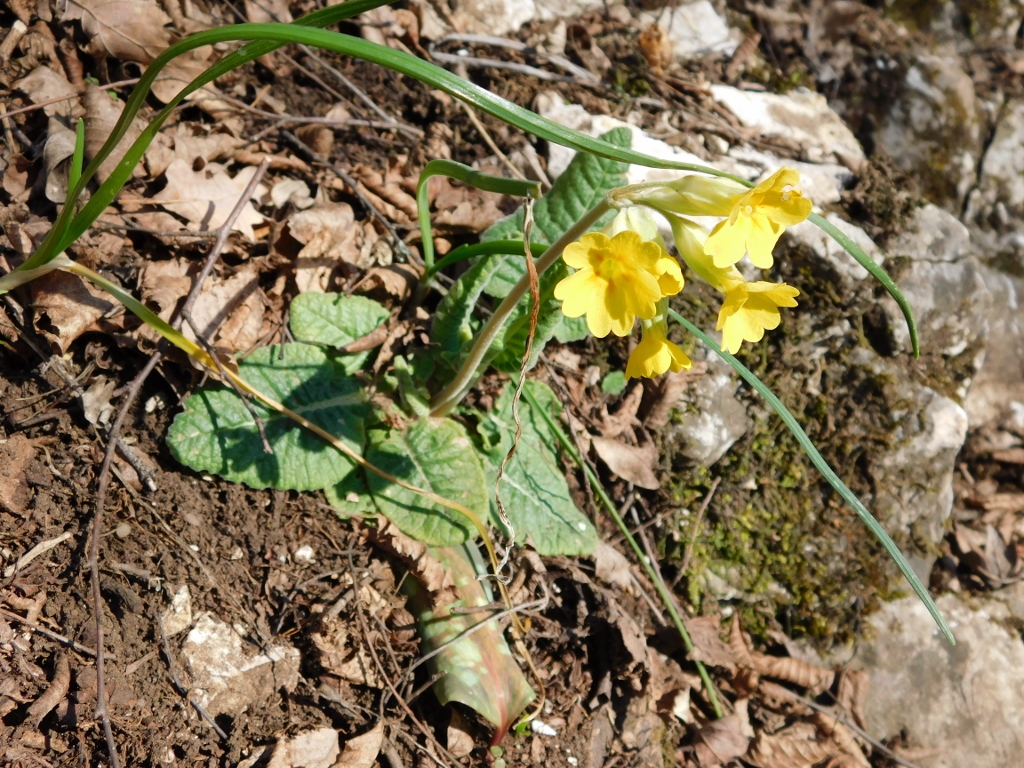 Cowslip (Primula veris)
Cowslip (Primula veris)
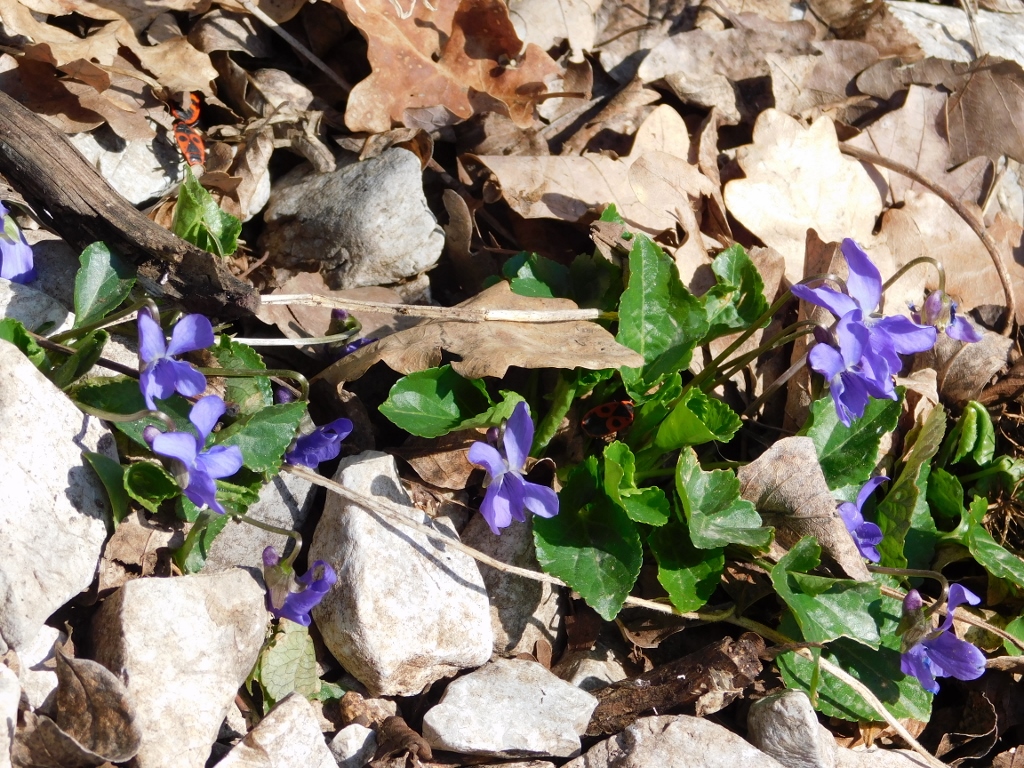 Sweet violet (Viola odorata); note the European firebug (Pyrrhocoris apterus) up left
Sweet violet (Viola odorata); note the European firebug (Pyrrhocoris apterus) up left
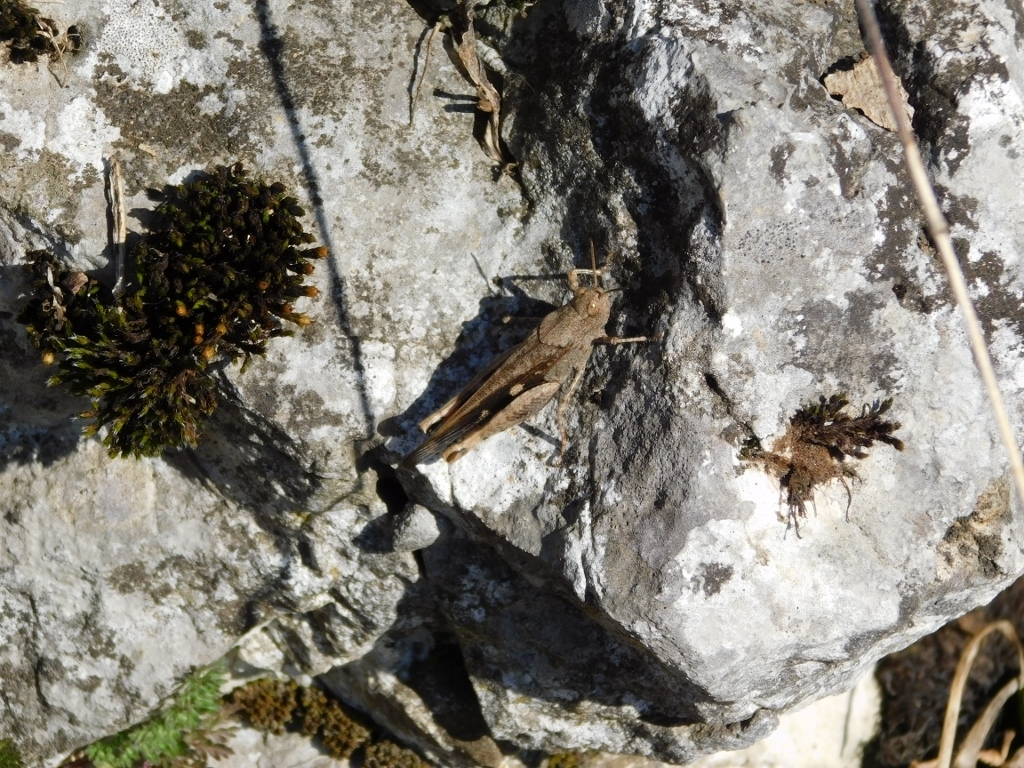 I think this is a grasshopper instar, rather than an adult specimen
I think this is a grasshopper instar, rather than an adult specimen
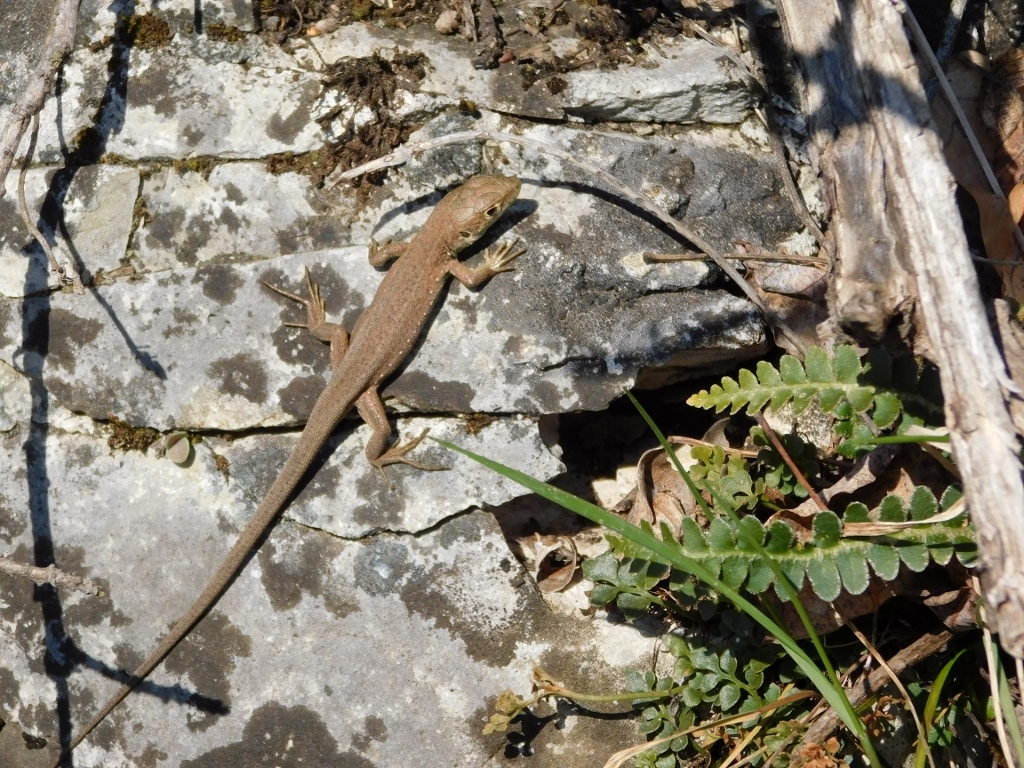 Meadow lizard (Darevskia praticola)
Meadow lizard (Darevskia praticola)
As it can be seen from the photos above, I mostly looked in front of me and down, since I had to walk carefully lest I twisted my ankle, but during those breaks I would also look up, wondering how will I ever get to the top.
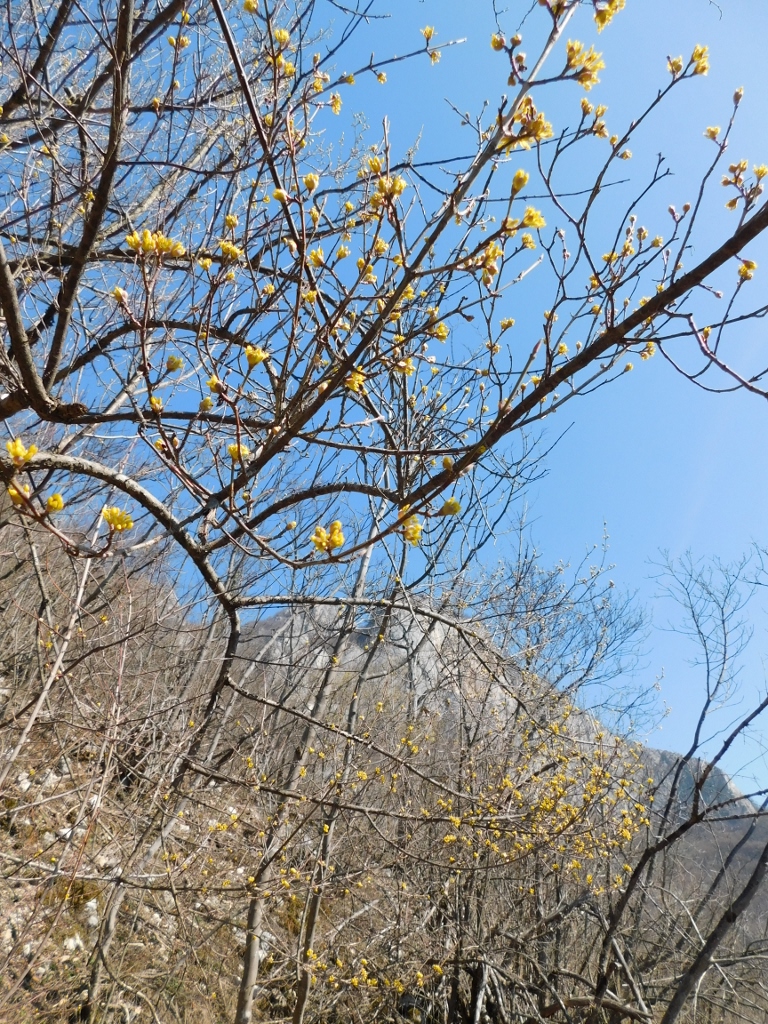 Early spring and the summit of Kablar which I should get to
Early spring and the summit of Kablar which I should get to
At some point, the trail goes straight along a cliff and there is a very nice place for a rest made, with a few memorial plaques affixed to the rock. I rested my trekking poles on the bench and then I went back to take a photo. I still worried about this summit that I could see in the distance.
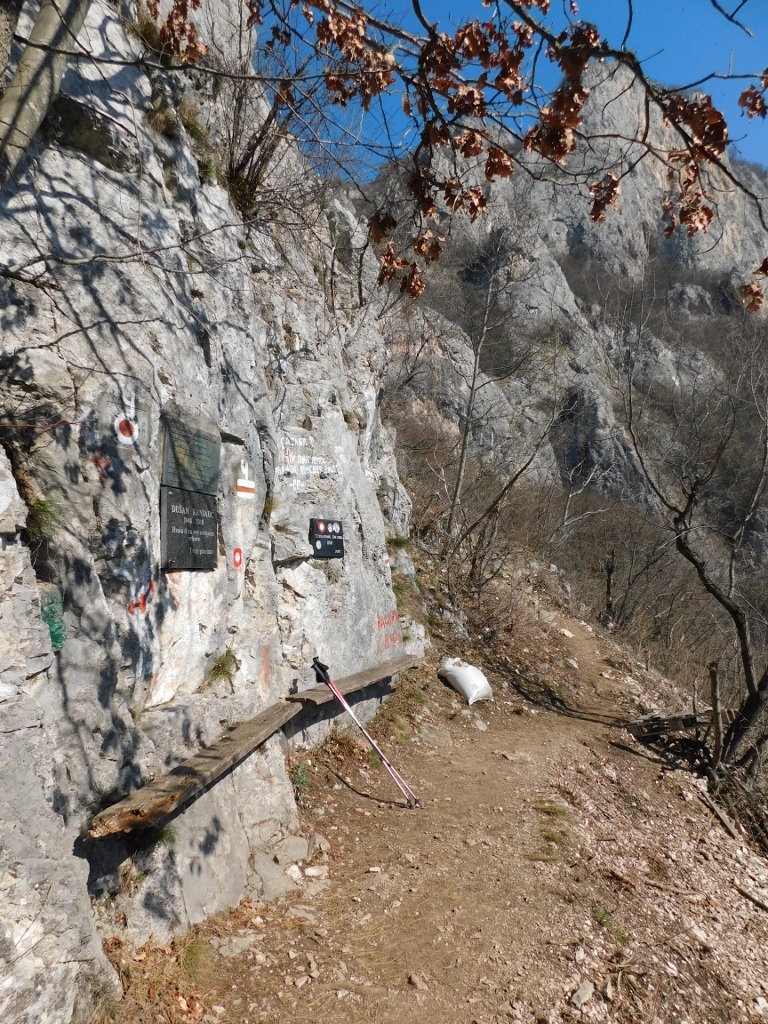 Rest area along trail no. 2
Rest area along trail no. 2
There is a very pretty view from here at mount Ovčar on the other side of the Zapadna Morava, although this is certainly not the only place from where one can enjoy a nice view.
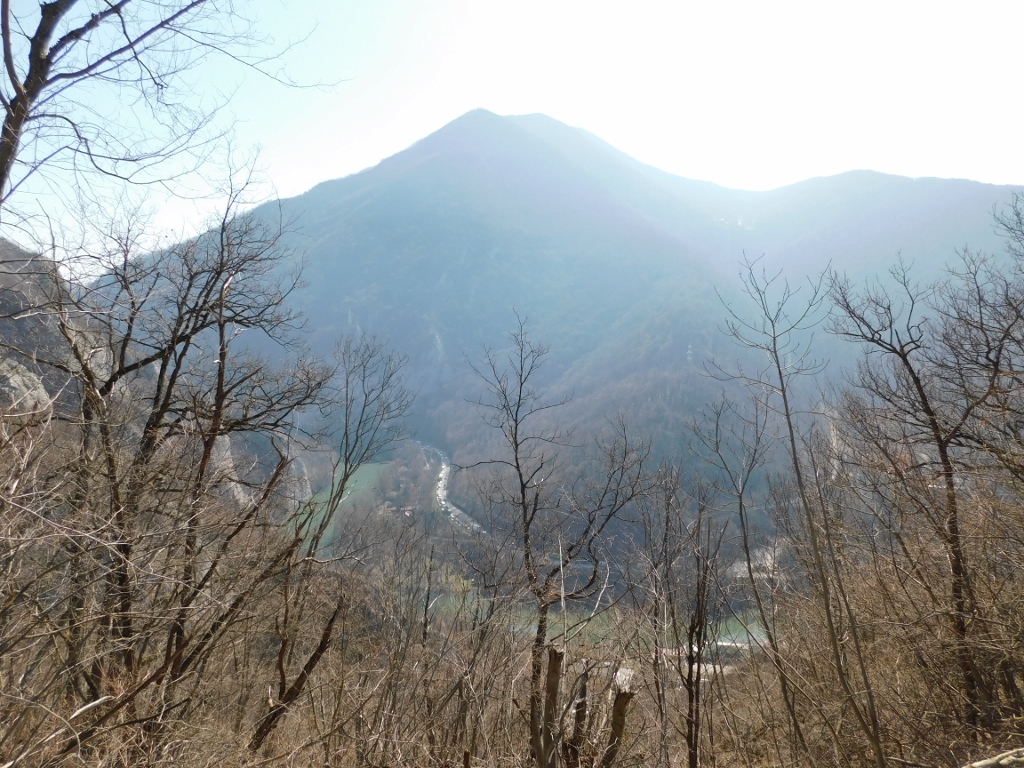 View at Ovčar and Zapadna Morava
View at Ovčar and Zapadna Morava
Right after this short and flat section comes a very steep one where one has to walk over rocks and for the sake of safety there is a thick metal cable installed there, so that hikers can hold on to it. Also, in this last part before Savina Voda, trails nos. 1 and 2 overlap.
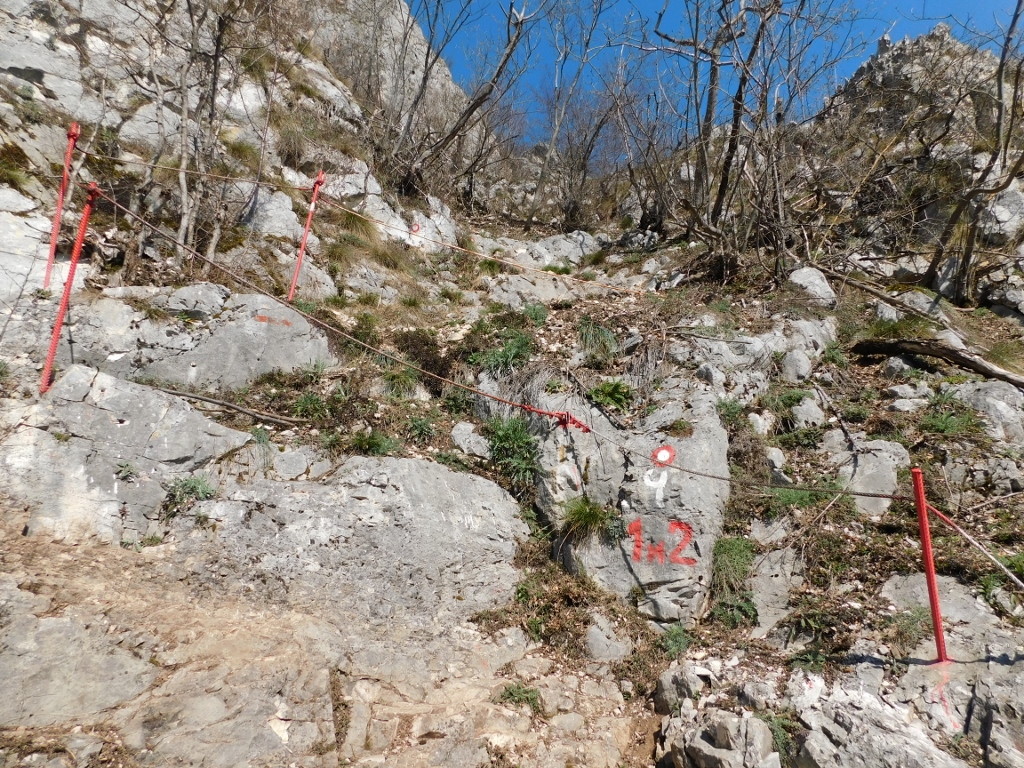 It is because of such sections, that trails nos. 1 and 2 are not for inexperienced hikers
It is because of such sections, that trails nos. 1 and 2 are not for inexperienced hikers
No matter how difficult I found it to climb here, at some point I did see the Hermitage of St. Sava.
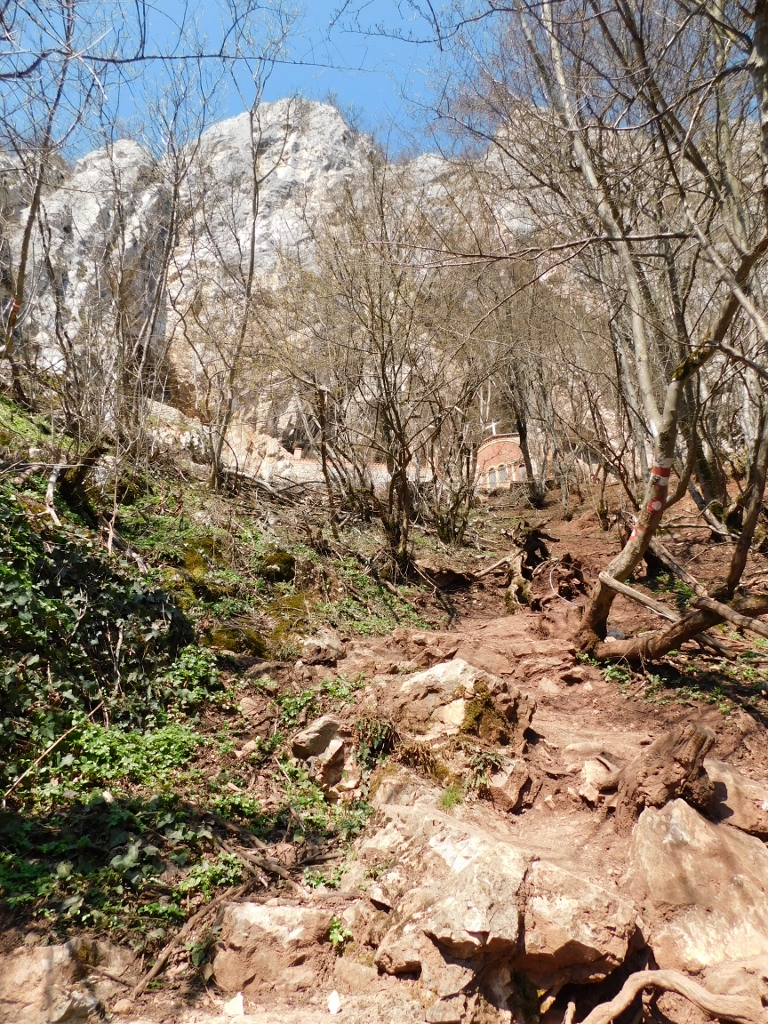 Finally I’m approaching the Hermitage of St. Sava
Finally I’m approaching the Hermitage of St. Sava
Although there was more soil, as well as more trees here than in the previous section, there is a metal cable installed here, too, because it is easier when one holds it.
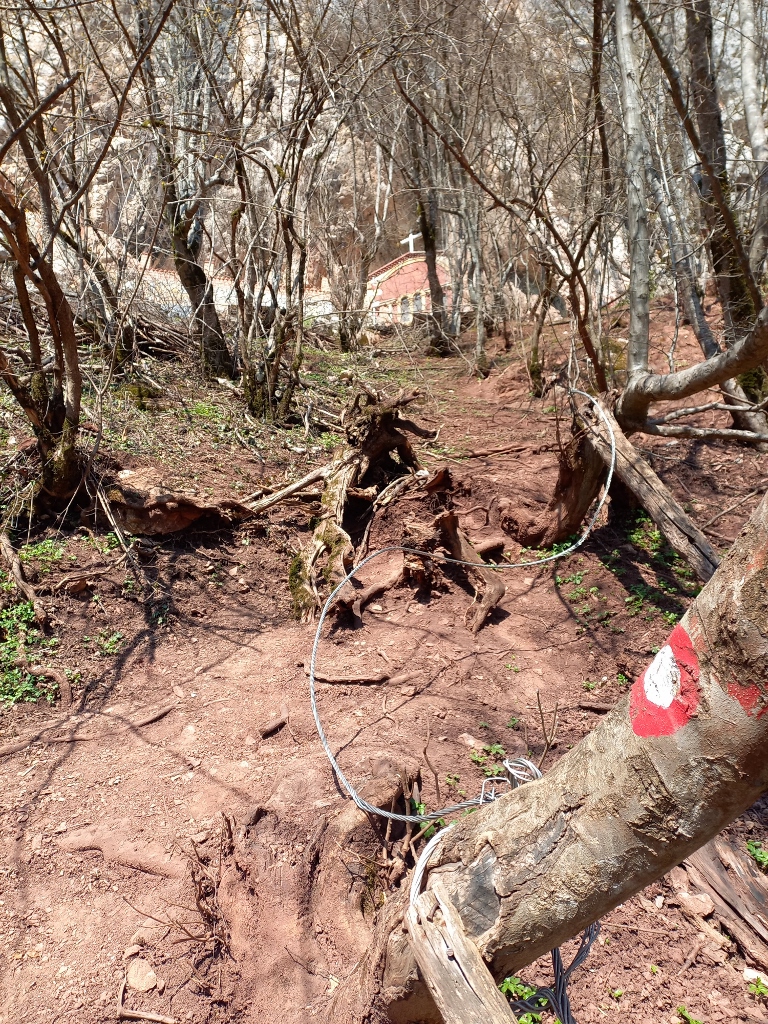 Cable along the steep approach to the Hermitage of St. Sava
Cable along the steep approach to the Hermitage of St. Sava
And then I finally reached my destination.
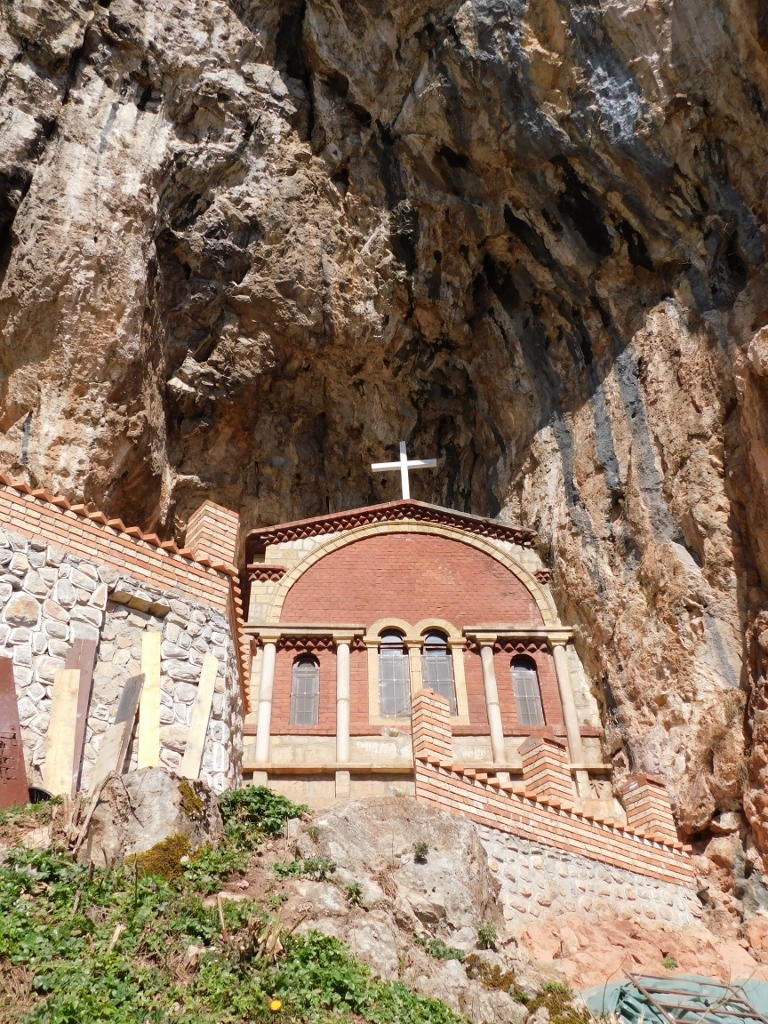 Hermitage of St. Sava
Hermitage of St. Sava
I have already mentioned that several names are used for this place – Savina Voda, Hermitage/church of St. Sava of the Church of Savinje. As it may be seen from the photos, it is tucked into steep cliffs, in a shallow cave in the middle of mount Kablar and it can be reached only on foot.
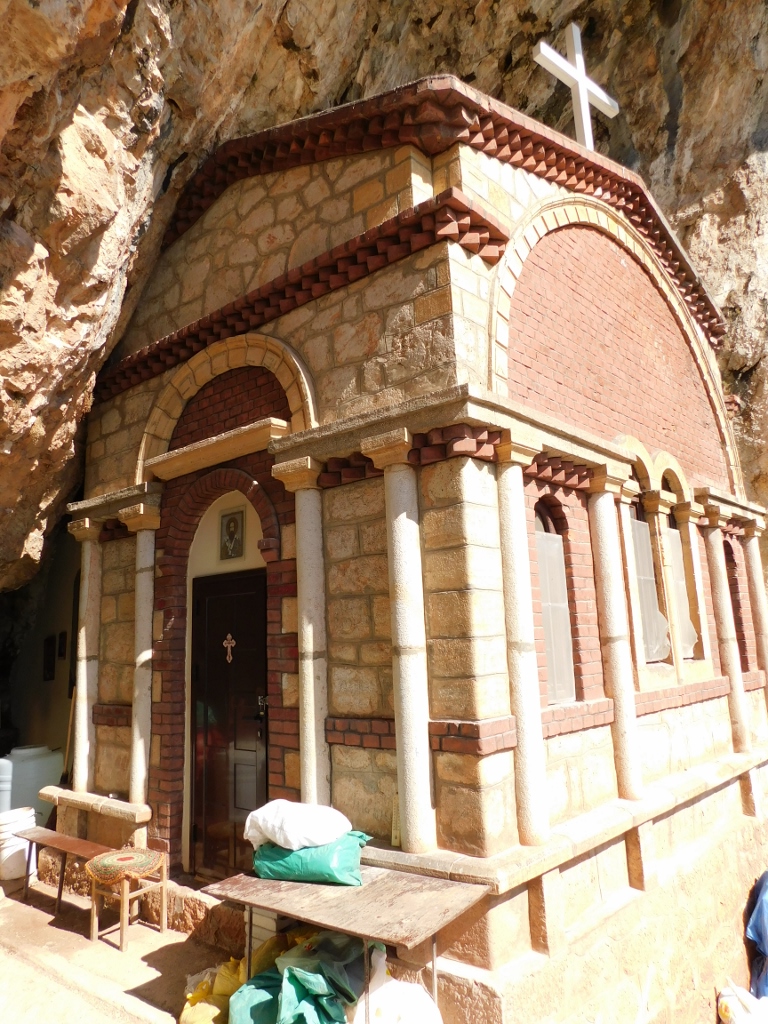 Hermitage of St. Sava
Hermitage of St. Sava
The legend says that Saint Sava spent some time here as a hermit and that while praying here he made water come out of the cracks in the rocks, which he then blessed as healing water – hence the name “Savina Voda” (Sava’s water). In 1938, a church was built here that was consecrated only in 1966. This small church is under the administration of the Monastery of the Transfiguration that is situated on the other side of the Ovčar-Kablar Gorge, closer to the road. The monastery can be seen quite nicely from the small plateau in front of the Heritage of St. Sava.
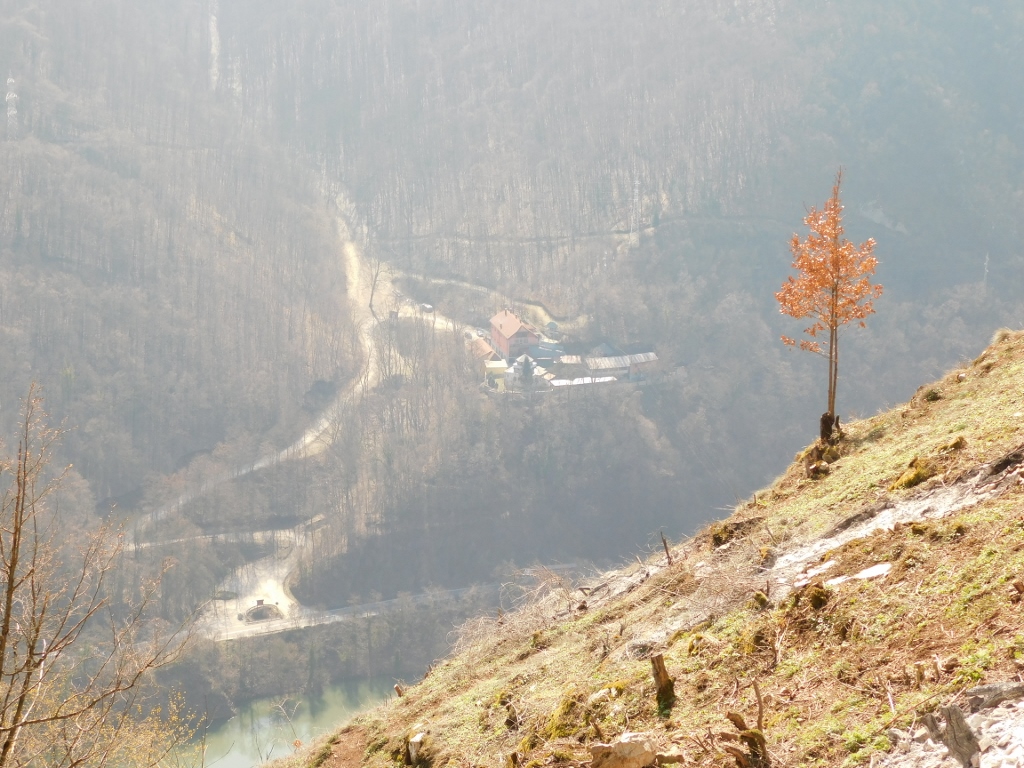 View at the Monastery of the Transfiguration
View at the Monastery of the Transfiguration
As for the water, I came across numerous vessels here, bigger or smaller, that were positioned in such a way that the water that was really dropping from the rocks was collected in them. I know that back in the day I heard that there were cases of miraculous healing using this water, which is apparently particularly good for eye diseases and poor sight.
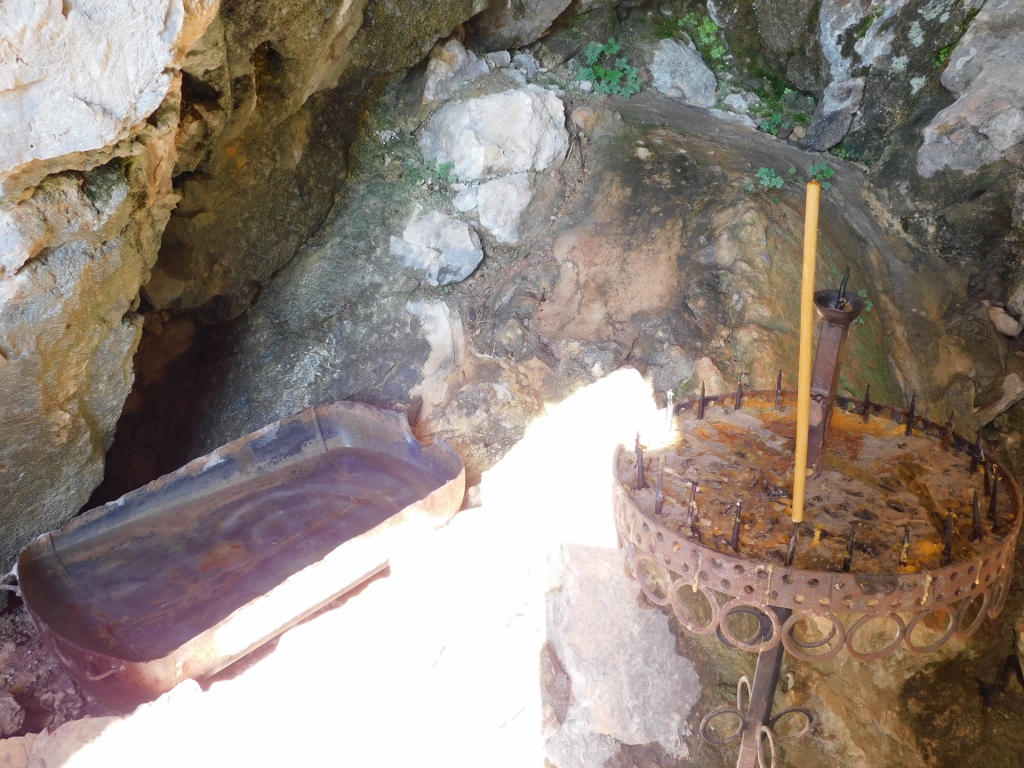 A metal vessel to the left collecting the water and the place for lighting candles to the right
A metal vessel to the left collecting the water and the place for lighting candles to the right
When I was here, the church was locked and there was a proper construction site around it. It was obvious that there were some works going one aimed at constructing and reinforcing the plateau in front of the church.
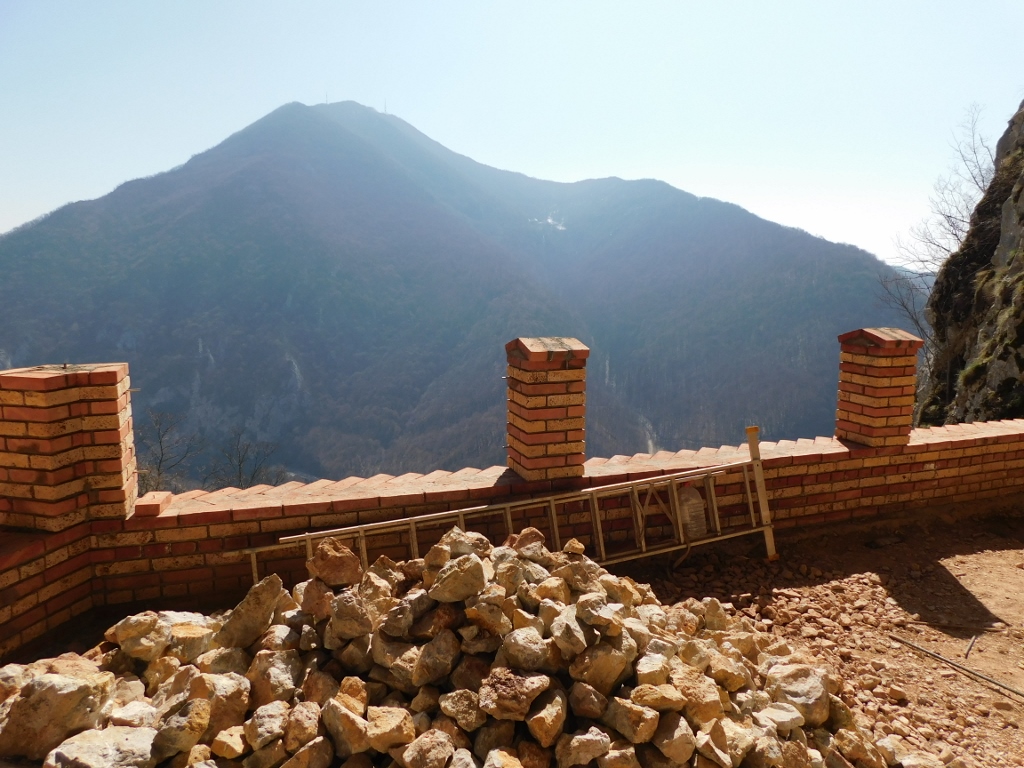 Construction and reinforcement of the plateau in front of the Hermitage of St. Sava and mount Ovčar in the distance
Construction and reinforcement of the plateau in front of the Hermitage of St. Sava and mount Ovčar in the distance
I remained here for a short while, resting, and then I had to continue.
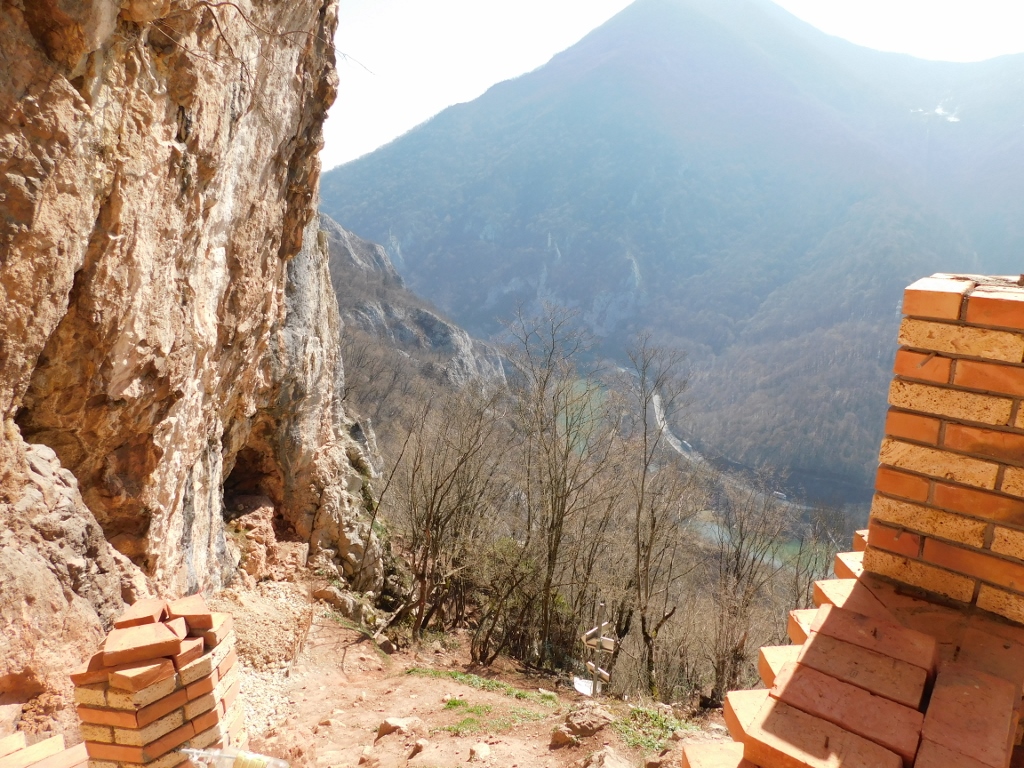 Before the trees, you can see some signs pointing at different trails
Before the trees, you can see some signs pointing at different trails
Frankly speaking, I would have given up climbing to the top of Kablar very gladly, but it was clear to me that it would be much more difficult (and dangerous) for me to go down the steep slopes than to climb them. That is why I decided to continue going up, with the idea to make as many breaks as I needed.